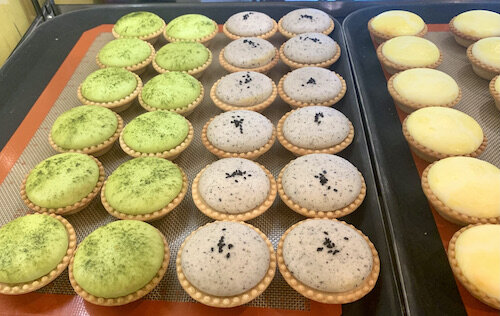Editor’s note: Pink Lady is the name of a famous Japanese pop group, an apple and a cheese tart company in NYC. The cheese tarts made primarily with cream cheese are a sensation, so we had contributor Anna Mindess find out more.

A cozy shop in New York Chinatown, called Pinklady, is the latest home for the irresistible ooze of sweet molten cheese in Japanese Cheese Tarts, which has been spreading around the globe. Owner Jean Lim grew up in Malaysia, where shops selling individual Japanese cheese tarts had been very popular with her friends and family for years. It was only in 2019, on a trip home from New York City, that she tasted one for the first time. “It was okay,” she said, “but it could have been cheesier.” The attraction of these cheese tarts is that eaten fresh out of the oven, their creamy middles offer an alluring molten melt of cheese, making them an instant Instagram darling.
Lim had moved to New York for college several years previously but realized that wasn’t the path for her. She had always imagined running a business. So, in 2020, she took a giant leap opened the petite Pinklady. “Life is short,” says Lim, “you have to go for your dream.”
This particular dream presented quite the learning curve for Lim, who had no previous experience in food businesses. “When you don’t have experience, Google is your best friend,” she says. She turned to YouTubers to perfect her recipe and technique and became a student at the school of trial and error. When a large machine she purchased to measure ingredients for the crust dough turned out not to be what she needed, the resourceful Lim sold it on eBay.
Pinklady’s Japanse Cheese Tarts
Photo credit Anna Mindess
Lim’s version of Japanese cheese tarts is she says, “less sweet, fluffier, easy to eat, and not heavy.” All 200-300 a day are made in the tiny kitchen at the back of Pinklady. Lim started with the original cheese flavor, which is still the most popular, adding five more options in a range of natural flavors and hues, (green matcha, purple ube, cocoa chocolate, silvery Black sesame, and original with blueberry filling.) The name Pinklady came to her in a dream.
Lim refrains from revealing her recipe secrets, but confesses it contains, “white cheeses, cream cheese, and cream, just a little sugar, but not too much.” (On YouTube, you can find recipes featuring cream cheese, mascarpone, and parmesan.) Pinklady’s menu describes the petite treats as actually having three variations, depending on the temperature at which you eat them: warm has an oozy center and is like eating a fluffy cloud. At room temperature, it is still soft and creamy. When cold it is firmer like cheesecake, but all are light and not too sweet.
History of Japanese Cheese Tarts

Although Jean Lim uses locally produced milk and cheeses, the story of Japanese Cheese Tarts began in Hokkaido, Japan’s northernmost diamond-shaped island and coldest region, with plenty of arable land, it leads the nation in raw milk production, that sports a uniquely pure taste.
The high quality of the milk is believed to derive from the ideal wide-open pasture where the dairy cows live, plus a cool climate, and fresh air. (You may not immediately connect Japan and dairy products, but the trend began in 1868, when Emperor Meiji first welcomed Western ideas as helpful for Japan’s progress. When he noticed how large and healthy foreigners looked, the Emperor enacted a major dietary change, declaring that eating meat and milk was essential to the good health of his citizens.)

Cheese tarts, the popular treat in question, was born by happy accident. The story credits Shintaro Naganuma, the eldest son of the family-run Kinotoya company, a Hokkaido-based confectionery famous for its blueberry tarts.
Attending a food fair in Singapore, Naganuma ran out of boxes to pack his popular tarts and quickly improvised by selling them to customers directly from his oven trays while they were still warm. Sales boomed, and an influx of customers lined up to buy the wobbly-centered tarts. Realizing he had a hit on his hands, Naganuma, removed the blueberries from the mix and opened BAKE, the shop that started the world-wide craze for warm, half-baked cheese tarts.
BAKE currently has over two dozen outlets in Japan, Korea, Thailand, Taiwan, China, Hong Kong, the Philippines, Malaysia, Vietnam, Singapore, Australia, plus two US locations, Los Angeles and San Francisco. (BAKE’s corporate office did not reply to repeated requests for an interview). There are other Japanese cheese tart companies too. The big difference is that BAKE takes advantage of Hokkaido’s special dairy products, and all of its tarts are made in their Sapporo, Japan factory and shipped frozen to their stores around the world, where they are freshly baked. BAKE’s website claims their cheese tarts are so popular that, worldwide, they sell one per second.
Jen and Jean Lim photo credit Anna Mindess and Jean Lim (R) with special box for their cheese tarts .jpeg photo_Anna Mindess.jpeg?format=1000w)
Back in Pinklady, a steady stream of customers come in, many of whom have learned about Japanese cheese tarts from Instagram, YouTube and TikTok. Almost everyone takes a bite and snaps a photo of the enticing oozing middle. Recently, Jean Lim’s twin sister, Jen, joined as co-owner. The 32-year-olds hope their buttery cookie crust tarts filled with fluffy, oozy cheese in natural flavors are the start of their own successful spread.
